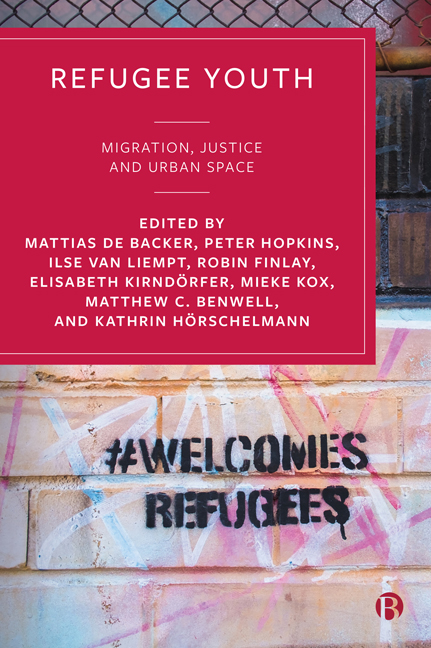Book contents
- Frontmatter
- Contents
- List of Figures and Tables
- Notes on Contributors
- Acknowledgements
- 1 Introducing Refugee Youth: Migration, Justice and Urban Space
- 2 Storying Belonging, Enacting Citizenship? (Dis)articulations of Belonging in a Community Theatre Project with Young Refugees and Asylum Seekers in Leipzig, Germany
- 3 Jackets and Jewellery: Racialised Dispossession and Struggles over Public Space in Denmark
- 4 Venezuelan Refugee Youth and Brazilian Schooling: The Individual between Languages and Spaces
- 5 The Inclusionary Potential and Spatial Boundaries of (Semi-)Public Space: Refugee Youth’s Everyday Experiences in the Urban Fabric of Amsterdam
- 6 Navigating ‘Purdah’ Culture in Urban Space: The Restricted Lives of Young Married Rohingya Refugees in Malaysia
- 7 Inclusive Urban Planning and Public Space for Refugee Youth in Pursuit of a Just City in Amman, Jordan
- 8 Sense of Belonging among Tibetan Refugees in India: A Case Study of the Bylakuppe Settlement in Karnataka, India
- 9 Negotiating Identity in Urban Space: Everyday Geographies of Syrian Students in Istanbul
- 10 ‘You’re Judged a Lot’: Australian Sudanese and South Sudanese Youths’ Perspectives on Their Experiences in Public Spaces
- 11 Hair Salons as ‘Private-Public Spaces’: Exploring the Experiences of Young Migrant Women in an Urban Township in South Africa
- 12 Emotion and Spatial Belonging: Exploring Young Migrant Men’s Emotional Geographies in Cork, Ireland
- 13 Homemaking through Music in Urban Africa: Creating Opportunities as a Refugee and a Migrant in Kinshasa and Dar es Salaam
- 14 Planetary Listening
- 15 Refugee Youth: Politics, Publicness and Visibility
- Index
7 - Inclusive Urban Planning and Public Space for Refugee Youth in Pursuit of a Just City in Amman, Jordan
Published online by Cambridge University Press: 18 January 2024
- Frontmatter
- Contents
- List of Figures and Tables
- Notes on Contributors
- Acknowledgements
- 1 Introducing Refugee Youth: Migration, Justice and Urban Space
- 2 Storying Belonging, Enacting Citizenship? (Dis)articulations of Belonging in a Community Theatre Project with Young Refugees and Asylum Seekers in Leipzig, Germany
- 3 Jackets and Jewellery: Racialised Dispossession and Struggles over Public Space in Denmark
- 4 Venezuelan Refugee Youth and Brazilian Schooling: The Individual between Languages and Spaces
- 5 The Inclusionary Potential and Spatial Boundaries of (Semi-)Public Space: Refugee Youth’s Everyday Experiences in the Urban Fabric of Amsterdam
- 6 Navigating ‘Purdah’ Culture in Urban Space: The Restricted Lives of Young Married Rohingya Refugees in Malaysia
- 7 Inclusive Urban Planning and Public Space for Refugee Youth in Pursuit of a Just City in Amman, Jordan
- 8 Sense of Belonging among Tibetan Refugees in India: A Case Study of the Bylakuppe Settlement in Karnataka, India
- 9 Negotiating Identity in Urban Space: Everyday Geographies of Syrian Students in Istanbul
- 10 ‘You’re Judged a Lot’: Australian Sudanese and South Sudanese Youths’ Perspectives on Their Experiences in Public Spaces
- 11 Hair Salons as ‘Private-Public Spaces’: Exploring the Experiences of Young Migrant Women in an Urban Township in South Africa
- 12 Emotion and Spatial Belonging: Exploring Young Migrant Men’s Emotional Geographies in Cork, Ireland
- 13 Homemaking through Music in Urban Africa: Creating Opportunities as a Refugee and a Migrant in Kinshasa and Dar es Salaam
- 14 Planetary Listening
- 15 Refugee Youth: Politics, Publicness and Visibility
- Index
Summary
Introduction
Cities emerge from, are shaped by and develop as a result of migratory movements and increasing urban diversity. Among this growing migrant population, the arrival of young refugees in urban settings with important differences such as class, race, language, trauma, education and family backgrounds (Marshall et al, 2016, p 3) has a transformative effect on the demographic, cultural, political and economic characteristics of cities. Incoming migration brings to cities a surplus of benefits such as needed skills, cultural diversity and entrepreneurship, which can boost creativity, innovation and economic growth (Price and Chacko, 2012, p 13). Simultaneously, many young refugees face difficult challenges in becoming active participants in the economic, cultural, social and political lives of their communities; these challenges can include lack of residency rights, lack of political representation, inadequate housing, restrictions to work or low-paid, insecure or hazardous work, limited access to state-provided services such as health or education, religious intolerance, discrimination based on race or gender, and social exclusion (Price and Chacko, 2012, p 34). Furthermore, ongoing antiimmigrant attitudes and contested relationship dynamics between newcomers and receiving communities can be perceived as ‘dangerous mobilisers in a context where the centre no longer holds’ (Sassen, 2013, p 3).
The prevalence of injustice in cities demands a persistent and revitalised pursuit for innovative ideas and solutions that can contribute to creating an inclusive city for all city inhabitants, including young refugees. An inclusive city is one that listens, values and places the challenges, needs and aspirations of its people at the centre of policy and design. An inclusive city provides multiple channels and platforms that enable city inhabitants to participate in shaping the spatial and material character of the cities they inhabit. Most importantly, an inclusive city encourages ongoing and constructive conversations between local planning authorities and the communities they serve around what constitutes a just and inclusive city. Ultimately, an inclusive city is one that values local communities as partners in shaping and managing the city. While this vision of an inclusive and just city can seem detached from the reality of how cities generally function and perform, cities devoid of inclusive urban policies and practices will continue to fuel injustices and lead to further segregation.
- Type
- Chapter
- Information
- Refugee YouthMigration, Justice and Urban Space, pp. 100 - 116Publisher: Bristol University PressPrint publication year: 2023



